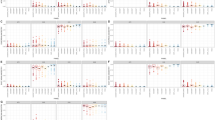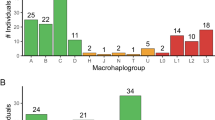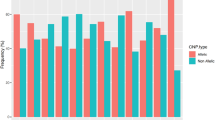Abstract
Advances in genotyping technologies have contributed to a better understanding of human population genetic structure and improved the analysis of association studies. To analyze patterns of human genetic variation in Brazil, we used SNP data from 1129 individuals – 138 from the urban population of Sao Paulo, Brazil, and 991 from 11 populations of the HapMap Project. Principal components analysis was performed on the SNPs common to these populations, to identify the composition and the number of SNPs needed to capture the genetic variation of them. Both admixture and local ancestry inference were performed in individuals of the Brazilian sample. Individuals from the Brazilian sample fell between Europeans, Mexicans, and Africans. Brazilians are suggested to have the highest internal genetic variation of sampled populations. Our results indicate, as expected, that the Brazilian sample analyzed descend from Amerindians, African, and/or European ancestors, but intermarriage between individuals of different ethnic origin had an important role in generating the broad genetic variation observed in the present-day population. The data support the notion that the Brazilian population, due to its high degree of admixture, can provide a valuable resource for strategies aiming at using admixture as a tool for mapping complex traits in humans.
Similar content being viewed by others
Log in or create a free account to read this content
Gain free access to this article, as well as selected content from this journal and more on nature.com
or
References
Patterson N, Price AL, Reich D : Population structure and eigenanalysis. PLoS Genet 2006; 2: e190.
Price AL, Patterson NJ, Plenge RM, Weinblatt ME, Shadick NA, Reich D : Principal components analysis corrects for stratification in genome-wide association studies. Nat Genet 2006; 38: 904–909.
Seldin MF, Shigeta R, Villoslada P et al: European population substructure: clustering of northern and southern populations. PLoS Genet 2006; 2: e143.
Paschou P, Ziv E, Burchard EG et al: PCA-correlated SNPs for structure identification in worldwide human populations. PLoS Genet 2007; 3: 1672–1686.
Heath SC, Gut IG, Brennan P et al: Investigation of the fine structure of European populations with applications to disease association studies. Eur J Hum Genet 2008; 16: 1413–1429.
Paschou P, Drineas P, Lewis J et al: Tracing sub-structure in the European American population with PCA-informative markers. PLoS Genet 2008; 4: e1000114.
Price AL, Butler J, Patterson N et al: Discerning the ancestry of European Americans in genetic association studies. PLoS Genet 2008; 4: e236.
Biswas S, Scheinfeldt LB, Akey JM : Genome-wide insights into the patterns and determinants of fine-scale population structure in humans. Am J Hum Genet 2009; 84: 641–650.
Xing J, Watkins WS, Witherspoon DJ et al: Fine-scaled human genetic structure revealed by SNP microarrays. Genome Res 2009; 19: 815–825.
McEvoy BP, Montgomery GW, McRae AF et al: Geographical structure and differential natural selection among North European populations. Genome Res 2009; 19: 804–814.
Auton A, Bryc K, Boyko AR et al: Global distribution of genomic diversity underscores rich complex history of continental human populations. Genome Res 2009; 19: 795–803.
Adeyemo A, Gerry N, Chen G et al: A genome-wide association study of hypertension and blood pressure in African Americans. PLoS Genet 2009; 5: e1000564.
Goncalves VF, Carvalho CM, Bortolini MC, Bydlowski SP, Pena SD : The phylogeography of African Brazilians. Hum Hered 2008; 65: 23–32.
Suarez-Kurtz G : Pharmacogenomics in Admixed Populations. Landes Bioscience: Austin, 2007.
Wright S : Genetical structure of populations. Nature 1950; 166: 247–249.
Duan S, Zhang W, Cox NJ, Dolan ME : FstSNP-HapMap3: a database of SNPs with high population differentiation for HapMap3. Bioinformation 2008; 3: 139–141.
Falush D, Stephens M, Pritchard JK : Inference of population structure using multilocus genotype data: linked loci and correlated allele frequencies. Genetics 2003; 164: 1567–1587.
Wang Z, Hildesheim A, Wang SS et al: Genetic admixture and population substructure in Guanacaste Costa Rica. PLoS One 2010; 5: e13336.
Yang N, Li H, Criswell LA et al: Examination of ancestry and ethnic affiliation using highly informative diallelic DNA markers: application to diverse and admixed populations and implications for clinical epidemiology and forensic medicine. Hum Genet 2005; 118: 382–392.
Kosoy R, Nassir R, Tian C et al: Ancestry informative marker sets for determining continental origin and admixture proportions in common populations in America. Hum Mutat 2009; 30: 69–78.
Enoch MA, Shen PH, Xu K, Hodgkinson C, Goldman D : Using ancestry-informative markers to define populations and detect population stratification. J Psychopharmacol 2006; 20: 19–26.
Acknowledgements
We thank the CNPq (Brazil, Grant 150653/2008–5) for partial financial support (SRG). This work was supported by FAPESP (Grant 2007/58150-7), and Hospital Samaritano, Sao Paulo.
Author information
Authors and Affiliations
Corresponding authors
Ethics declarations
Competing interests
The authors declare no conflict of interest.
Rights and permissions
About this article
Cite this article
Giolo, S., Soler, J., Greenway, S. et al. Brazilian urban population genetic structure reveals a high degree of admixture. Eur J Hum Genet 20, 111–116 (2012). https://doi.org/10.1038/ejhg.2011.144
Received:
Revised:
Accepted:
Published:
Issue date:
DOI: https://doi.org/10.1038/ejhg.2011.144
Keywords
This article is cited by
-
Black and non-black population: investigation of the difference in butyrylcholinesterase activity in a healthy population in Salvador, Bahia
Irish Journal of Medical Science (1971 -) (2023)
-
Somatic targeted mutation profiling of colorectal cancer precursor lesions
BMC Medical Genomics (2022)
-
Association of Toll-like receptors polymorphisms with the risk of acute lymphoblastic leukemia in the Brazilian Amazon
Scientific Reports (2022)
-
Genetic ancestry inferred from autosomal and Y chromosome markers and HLA genotypes in Type 1 Diabetes from an admixed Brazilian population
Scientific Reports (2021)
-
Association between vitamin D plasma concentrations and VDR gene variants and the risk of premature birth
BMC Pregnancy and Childbirth (2020)



